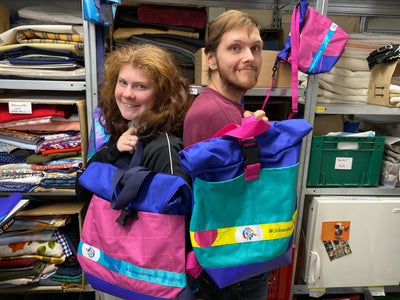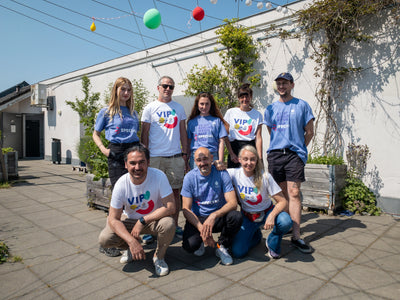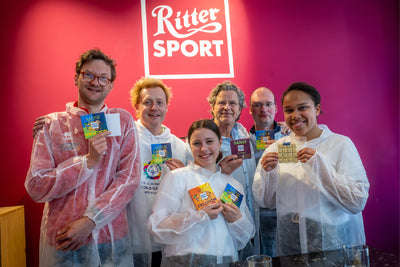There is a lot to see at Manufaktur Blumenfisch: Ronald Bluhm (left) gives Special Olympics intern Julian Stegemann an impression of the site in Berlin Schöneberg. Many of the employees' works of art are on display.
Ronald Bluhm has
worked at Blumenfisch for many years and has already experienced a lot in this
time. The PR and Public Relations employee told us what he finds typical of
Blumenfisch, how the Blumenfisch name came about and who is part of
Blumenfisch.
Mr Bluhm, we’d like to
learn more about Blumenfisch. What do you consider typical of Blumenfisch?
The first thing that comes to mind immediately is that we are more
colourful, creative, instrumental. It’s important to us to involve our
employees in all processes. There are always lots of work areas, topics and
wishes to which we can apply ourselves. We gather in work groups to discuss
matters such as what happens in old age or how we would like to be addressed.
The joint development is already remarkable. Everyone gets to give their views.
Of course, this also helps to prepare our people for the general labour market.
How did this unusual
company name come about?
That had something to do with the company’s beginnings. Our first
ever project was a small art workshop or studio. Our trademark at the time were
cheerful, colourful fish made of papier-mâché and styrofoam. This studio was
located in a rear courtyard in the Prenzlauer Berg neighbourhood. One day, we
got the opportunity to take over a retail store facing the street. We then set
up a flower shop there. Putting the fish and the flowers together, the name
Blumenfisch (“flower fish” in German) was born.

Focus on creativity: Countless artistic designs are developed at Blumenfisch. Here are some colourful animals. (Photo: www.blumenfisch-berlin.de)
A name with which your
employees can also identify.
Certainly.
Blumenfisch is not a descriptive name. Nobody likes to have their shortcomings
pointed out. The name Blumenfisch is open and playful and somehow also matches
everything we offer.
Who
works for and with Blumenfisch?
Currently, there are around 400 people in five different locations in Berlin. We have a total of 18 occupational fields. These include classic crafts, gastronomic offerings, services and arts. We also offer drama, which has a certain rarity value.
In addition to the craft
side of its operations, Blumenfisch is also known for its association with the
arts. What is the significance of art, culture and the theatre here?
These are extremely important to us and also part of our profile.
This includes, for example, the design products that we develop ourselves.
These can be quite artistic. Actually, we also have some individuals with
talents that we are able to further foster in our studio. And there’s our
connection to the theatre.
An area in which
Blumenfisch is also active.
We still have a stage and scenery design department that carries out
contract work involving plastic materials. But that’s also where creative
things may emerge that we can then offer in our store.
What
role does sport play at Blumenfisch?
Sport is very
important to us. We’re actually still the reigning football champions in
Berlin. We play there in a league with another 17 sheltered workshops. In
addition, there are also many accompanying sports courses. Once a week, we
offer all employees an hour of sports. Our accompanying courses include
fitness, yoga and self-defence classes for women.
Has there been a recent highlight at Blumenfisch or is
there something special in the pipeline?
What we are certainly always particularly proud of is the Parieté Parieté Gala. This is an inclusive gala at which artists with and without disabilities can spend an evening together. This takes place at quite a high level with a mega-show. At least 80 of our employees are also involved there in all kinds of areas: behind the scenes, in wardrobe, with the floral arrangements or even on the stage itself. This is a very special event, which unfortunately could not be held for the past two years.
Thank you Mr Bluhm for these great insights!





